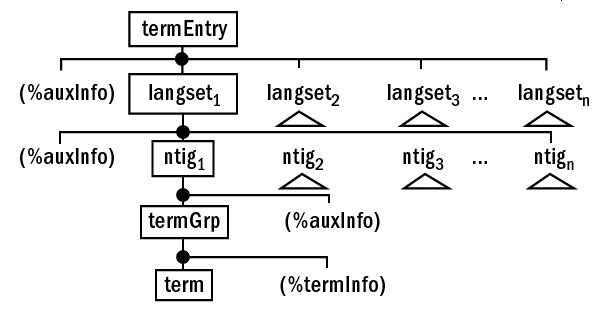TTT
Homepage
CLS Framework
Introduction
Section map
Overview
Applications:
·Representation
·Design
·Sharing
ISO 12620
data categories
Downloads
XML information
Copyright © 2000
Translation Research Group
Send comments to comments@ttt.org
Last updated: January 27, 2001 |
Applications of the CLS Framework:
Representation
The structure of an existing termbase is often implicit. The "box and line" method can be used to make the structure of concept entries explicit. This method, though simplistic, is easily understood by people without a technical background. It is based on genealogical trees and linguistic diagrams.
- The first step in representation is to identify the types of data elements found in a concept entry. Typically, these will be fields, also called cells, in a database. Please note that the representation task itself does not involve mapping these elements/fields/cells to the standard data element types in ISO 12620.
This process is illustrated in a separate file using sample data courtesy of Oracle corporation.
- The second step in representation is to identify the implicit relationships among the data elements. You may want to use the following box and line method. The following is the basic diagram of the CLS Framework:
Basic diagram of the CLS Framework termEntry:

For those who are interested, the above diagram reproduced exactly the structure defined in the following DTD-like statement of the basic structure of the CLS Framework:
Simple DTD-like representation:
|
termEntry ((%auxinfo;),(langSet+))
|
|
langSet ((%auxInfo;), (ntig)+)
|
|
|
ntig (termGrp, %auxinfo;)
|
|
|
termGrp (term, %termInfo;)
|
(NOTE: A triangle below something indicates that its structure has not been expanded. Boxes surround the name of each item that can be expanded according to the rules in the DTD. Although this page does not attempt to explain the syntax of a DTD, please note that a + symbol indicates that 1 or more of an element is required and the * sign that 0 or more may be present.)
Further guidelines for representation and design of termbases are currently being developed by ISO Technical Committee 37, Subcommittee 3, Workgroup 4.
Representing an existing termbase imposes the minimum amount of constraint possible. One can even represent a termbase which has features that are considered undesirable and violate good design principles (and hence would not be implemented in a new termbase). All other applications of the CLS framework are based upon the assumption that data has to be represented before it can be worked with.
| Return to ttt homepage
| Introduction
| Section map
| Overview
|
| Applications: Representation; Design; Sharing |
| ISO 12620 Data Categories
| Downloads
| XML info |
|
![[CLS Framework]](images/clshead.gif)
![]()
![[CLS Framework]](images/clshead.gif)